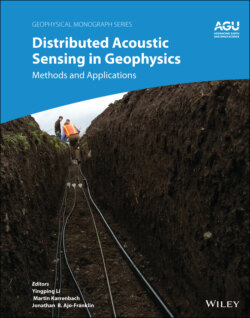Читать книгу Distributed Acoustic Sensing in Geophysics - Группа авторов - Страница 27
1.3. DAS WITH PRECISION ENGINEERED FIBER
ОглавлениеIn this chapter, we consider how the scattering properties of conventional fiber can be engineered to deliver better DAS performance (Figure 1.24). We will show how an SNR improvement can be achieved, along with a wider dynamic range, using engineered fiber with precisely uniform scattering centers. This approach differs from a simple increase in irregular backscattering intensity (Westbrook et al., 2017). We also consider the trade‐offs between spatial resolution, signal‐to‐noise performance and frequency response, and present data acquired from several different seismic and microseismic surveys.
Figure 1.21 3D VSP: Two intersecting images processed from DAS seismic data acquired with the dynamite shot positions indicated from Miller et al. (2016).
Figure 1.22 DAS hydraulic fracture monitoring in the treatment well with a fine spatial resolution and wide dynamic range for simultaneous cluster fluid allocation and microseismic monitoring.
DAS performance is largely governed by how much light can be usefully collected from the optical fiber. In general, we require low‐loss fiber for long range sensing, but higher scattering fiber to generate more light. These two apparently contradictory requirements can be balanced by engineering bright scatter centers in the fiber, without introducing significant excess loss for the forward propagating light. This can be achieved, for example, by using fiber Bragg grating technology.
For long fiber lengths, 100 times more light than Rayleigh level can be safely used (Farhadiroushan et al., 2021). That gives 20 dB reduction of acoustic noise caused by quantum shot noise at frequencies of around 1 kHz. This improvement can be even more at low frequencies as pink noise is suppressed by the regular structure of scattering. So, noise reduction can be more than 30 dB at around 1 Hz. This prediction was successfully confirmed in field surveys and are presented at the end of the chapter.
Figure 1.23 DAS hydraulic fracture monitoring in the offset (a) with a fine spatial resolution for microseismic monitoring (c), and localizing of microseismic events in time and space (b).
Figure 1.24 DAS with standard fiber and engineered fiber with precision bright scatter center zones.
